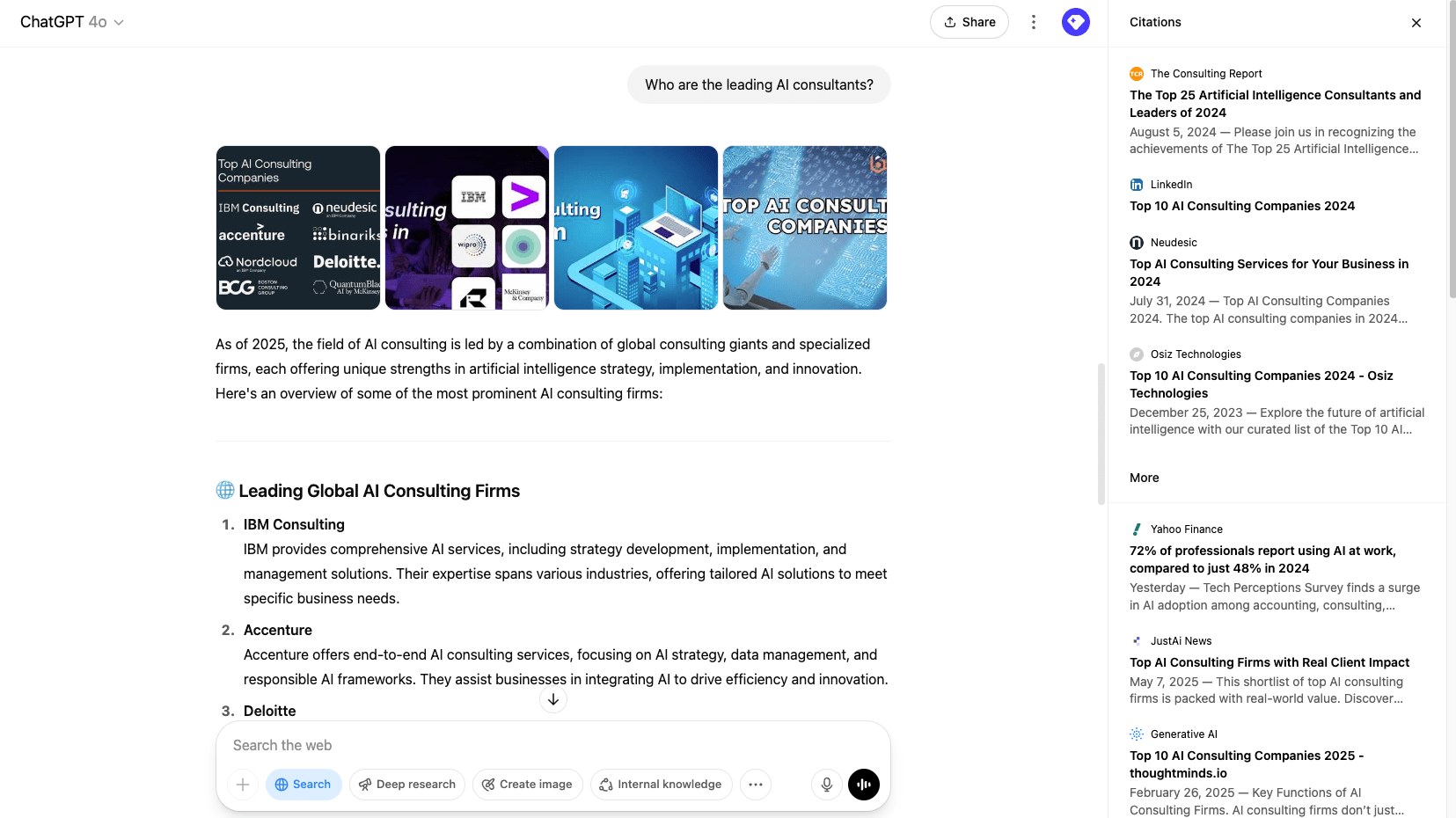Traditional search engine platforms are increasingly integrating artificial intelligence (AI), and generative AI platforms are integrating search capabilities more and more. As a result, search user behavior is continuing to shift.
While analyses of these behavioral changes often focus on generations or age groups, for business-to-business (B2B) brands, the most relevant way to determine if an audience is using AI-enabled search platforms like ChatGPT Search, Perplexity, Google AI Mode, etc. is not age — but rather how much generative AI is being adopted within the industries and job functions of their ideal clients. And yet, the more companies lean into AI-first approaches, the more B2B brands can assume that most — if not all — B2B target audiences are using AI-enabled search at key moments in their buying journeys.
As the “right place” part of the “right message, right time” mantra increasingly becomes AI-enabled, B2B brands seeking to meet their target audiences where they are must embrace generative engine optimization. But what is that, exactly?
What Is Generative Engine Optimization?
Generative engine optimization is the practice of maximizing meaningful brand mentions in AI-enabled search platforms. Also referred to as AI search optimization or answer engine optimization, this practice leverages both the synergistic nature of large language models (LLMs) and the importance of contextual relevancy for language comprehension.
How to Do Generative Engine Optimization (GEO)
Google aims to deliver search results that have strong Experience, Expertise, Authoritativeness, and Trustworthiness (E-E-A-T). While it isn’t confirmed as a direct factor in the Google Search ranking formula, E-E-A-T does help align your content with the definition of what a good search result is — on any AI-enabled search platform, Google’s or otherwise.
Embracing E-E-A-T in content can involve everything from using credible sources, citing real-world experience, and providing statistics, to featuring authentic user-generated content and following editorial standards and guidelines.
While keeping E-E-A-T top of mind is crucial, the key to successfully implementing GEO is understanding the basics of how LLMs work and utilizing this knowledge to:
1. Maximize brand mentions by capitalizing on synergy.
The LLMs used by AI-enabled search platforms synergize information from multiple sources to deliver a consensus on a topic. Since the LLMs of today’s leading AI-enabled search platforms leverage web content published across paid, earned, shared, and owned (PESO) media, the more your brand is mentioned in that content, the better.
But capitalizing on synergy doesn’t mean you should regurgitate what everyone else says into your content — quite the contrary, especially if you want your content to resonate with your human audience and drive revenue. (More on this later: See PAN’s Approach to Content for GEO at the bottom of this section.)

2. Maximize meaning by capitalizing on contextual relevancy.
Because LLMs decode and replicate patterns in written language to generate contextually relevant outputs, the more your brand is mentioned with terminology and phrases that are meaningful to your audience, the better.
This is where a lot of traditional on-page search engine optimization best practices can come into play. But contextual relevancy isn’t limited solely to the content “on the page.” The nature of the website publishing the content is also a key factor.
This means that, in addition to applying an audience-first approach to your own website’s content, you must keep your audience at the forefront of the content provided to industry publications.

>> Related Read – How to Get Listed in AI Platform Responses
3. Ensure the content on your website is crawlable by, and structured for, AI bots.
In much the same way you can grant Google access to your web content by making sure that your robots.txt file allows user-agents “Googlebot”, “AdsBot-Google”, and “Googlebot-Image” to crawl your website, you can add similar directives for the AI bots used by the leading AI-enabled search platforms. For example:
User-agent: GPTBot
Disallow:
If you don’t want the AI bots to crawl your entire website, you can add specific directives to designate which parts of your site they can explore and which they should avoid. The important word there is “should,” as not all AI bots respect the rules found in a robots.txt file.
While a proposed web standard called llms.txt was introduced in late 2024 as a way to provide LLM-friendly content to AI systems, the efficacy of the practical implementation of llms.txt is hindered by adoption, and the fact that robots.txt files and XML sitemaps already serve much the same purpose for web content crawlability and indexability.
In lieu of llms.txt, some sites publish an AI disclosure or training page — but the most widely accepted best practice right now is keeping your robots.txt and XML sitemap updated and open to crawling the right content while leveraging structured data, like Schema, and other on-page SEO best practices. The following Lightning Talk from Google Search Central is helpful for getting started with structured data:
4. Monitor and analyze your brand’s visibility by LLM model.
This can be automated via for-purchase options, like Semrush’s AI Toolkit and Enterprise AI Optimization solutions, or done manually via the AI platforms themselves. This free, downloadable Google Sheets template is a handy resource that can be used in tandem with GPT for Sheets to guide and scale manual analyses.
5. Monitor and analyze traffic coming to your website from AI platforms.
Creating a GA4 exploration of AI platform traffic can enable deeper investigation of GEO impact, including analyses of the traffic’s propensity to stick (engage) and convert. Here’s how to set one up:
- Sign in to GA4.
- Select Explore from the navigation on the left.
- Select Blank to create a new Free Form exploration.
- Choose the Table under Visualization.
- In the top left, give your exploration a name like AI Platform Traffic.
- Choose your date range.
- Add the dimensions of Page referrer and Landing page + query string, and then click Confirm.
- Add the metrics of Sessions, Engagement rate, and Session key event rate, and then click Confirm.
- Drop or select your dimensions in the Rows boxes.
- Set Show Rows to 500 for a more comprehensive view.
- Set Nested Rows to Yes to group Landing page + query string URLs under their Page referrers.
- Drop or select your metrics in the Values boxes.
- Drop or select Page referrer in the Filters box.
- Under Filters > Conditions, select the match type of matches regex. Copy and paste the following regex into the Enter expression box and click Apply:
.*(openai\.com|chatgpt\.com|gemini\.google\.com|claude\.ai|perplexity\.ai|metaai\.com|meta\.com/ai).*
NOTE: This particular regex includes OpenAI, ChatGPT, Gemini, Claude, Perplexity, and Meta AI. It can be tweaked to cover the platforms you desire, but bear in mind that the “Enter expression” box in GA4 does have a character limit. Additional tips on regex for GA4 can be found here.
The cherry on top of the GEO sundae is that your audience’s awareness of your brand grows, thanks to the readerships of the PESO media sites. And, as your audience’s awareness grows, queries about your brand within AI-enabled search platforms increase. This trains the LLMs, too — all while creating audience demand for your brand.
>> Related Read – Brand to Demand: What It Is and How It Works for B2B Marketing
PAN’s Approach to Content for GEO
To avoid getting lost in a sea of sameness, we recommend that B2B brands innovate with authentic thought leadership first and then build consensus. This means crafting and publishing content designed to differentiate your brand and shape your audience’s perception while leaning into:
- Real-world experience: Leverage what your brand’s subject matter experts have learned, seen, and done to spark a noteworthy theory or novel strategy.
- Collaboration: Get other subject matter experts to weigh in on that theory or strategy.
- Ownership: Call it ownership. Call it branding. Call it PAN’s approach to content for GEO.
- Distribution: Spread the word about that theory or strategy across PESO media, embracing the storytelling techniques of the digital channels your audience prefers.
- Engagement: The more that theory or strategy is talked about online, the more consensus builds.
- Proof: Demonstrate the practical viability or applied efficacy of that theory or strategy.
Use your people, work, network, brand, messaging, and media placements intentionally and strategically to make a splash with your content. Then, ride the waves of engagement to drive consensus, awareness, positive perception, and revenue. An AI marketing and PR agency that deeply understands your brand, SEO, GEO, and today’s media landscape can be your best ally.



